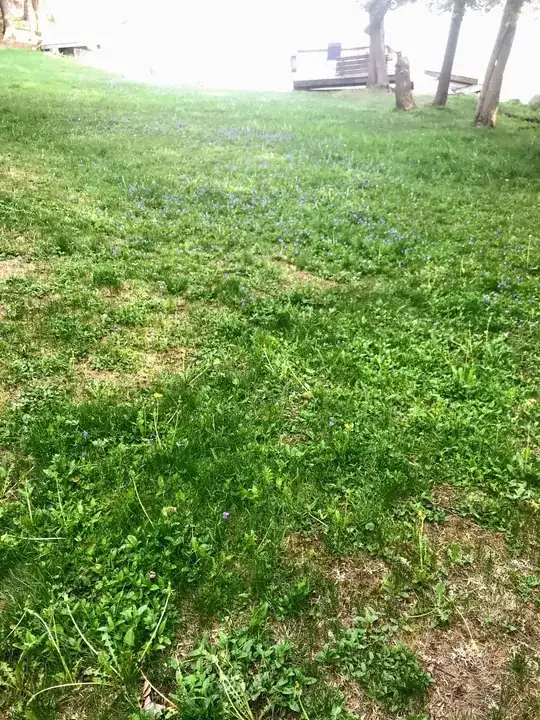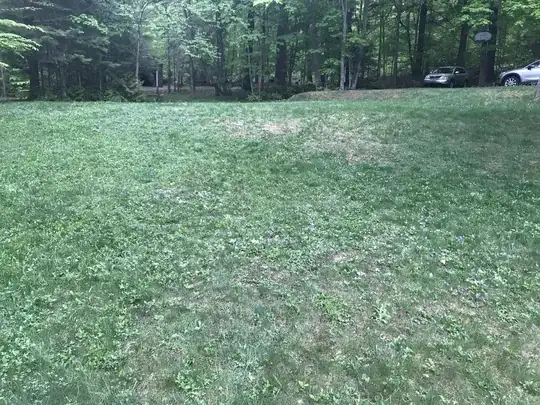First time poster on stack, hoping to get some advice on how to restore a lawn. The property here is a cottage in Ontario, right on the water (as you can see from the picture). What you can also see in the picture is an utter infestation of all kinds of weeds.
Here is a picture looking in the other direction:
Some backstory: We rebuilt the cottage in fall of 1998 and at that time reseeded and top-dressed the lawn in the fall, after all the machinery and construction was finished. The next summer the lawn grew in quite nicely, and we had a decent lawn for a couple years. In one picture I have from 2005 though, seems like the weeds had already infiltrated the lawn:
Since then it has been a peaceful coexistence with weeds and the lawn, with us overseeding each year hoping to gradually drive out the weeds. Unfortunately, that hasn’t happened.
The lawn is roughly 375 squaremeter. Its sort of in an L-shape, where one leg of the L runs parallel to the water with a very slight slope, and the second leg runs away from the water with two moderate slopes, with a plateau (where the septic tank is).
The soil composition is fairly sandy in the upper areas of the lawn, especially on the hills and septic bed (leg of L that runs away from the water). The lower portion along the water has a ‘blacker’ looking soil with less sand.
Running a simple soil test (4 vials with different coloured caps) bought at walmart showed the current lawn has very little nitrogen ANYWHERE, and low-to-moderate levels of phosphorous and potash. Based on this test, the pH seems to be anywhere from 6-7.0 depending on the part of the lawn. We have a fair amount of moss growing in the lawn as well, in certain spots.
Our typical lawncare routine is as follows:
- Spring - manual dethatching, fertilizing, overseeding, watering when possible
- Summer - nothing
- Fall - raking leaves (too many to mulch and keep on lawn)
- Aeration - have not done this in at least 10 years
- Top-dressing - don’t usually do this as we need about 7 yards or so, to get even one inch of coverage on the whole lawn. It’s hard for me to spread all this myself, and to have it delivered.
- Seeding - we typically buy the scott’s or promix grass seed from the big-box stores.
Last year I used a mower attachment dethatching blade (with the springs) and essentially scalped the lawn, We then ran a slit seeder and overseeded, and kept it moist until we saw the seedlings. We had a fairly green turf last year, but it wasn’t all grass. I am wondering why there are so many weeds this year.
At this point, given the abysmal state of the lawn, I am considering all options for how to restore it. Temperatures in this area are still in the high teens and high single digits through June, so we do have some time to grow grass. The options I have laid out for myself:
- Use selective herbicide
- Use Par3 or other selective herbicide to kill the weeds
- Reseed the lawn, possibly with slit seeder?
- Top-dress?
- Manually weed during the summer
- Use herbicide again in late summer
- Reseed and possibly top dress again in fall
- Next summer maintain lawn
- Use non-selective herbicide
- Spray everything and kill it all, with a light application
- wait a few weeks and then reseed and top-dress
- Maintain with a routine similar to the above
- Manually weeding certain areas?
Are there any suggestions for how to restore this lawn? Also, how would you maintain it year after year? I am open to using something like Par3 after many hours of research, as we often are away during the week and if applied before we leave for the city I don't expect any issues of exposure. Is there something that I am missing?


